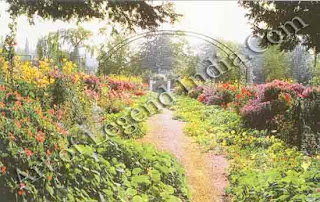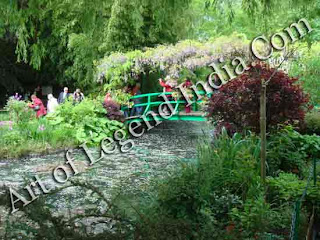Monet`s Garden
The
magnificent garden at Giverny took Monet almost 20 years to create, and
demanded all his artistic skills and imagination. For the rest of his life, it
provided endless subjects for his paintings.
Rarely
has an artist left behind such a complete record of his inspiration as did
Monet at Givemy. There, in the garden on which he lavished care and attention
for over 40 years, view after view conjures up his paintings: the lily pond,
the footbridge, the rose trellises. The garden was really an extension of his
art.
Givemy
lies some 40 miles north-west of Paris, in the rolling countryside of Normandy,
where two small tributaries, the Epte and the Ru, flow into the Seine. The
village nestles against wooded hills, overlooking a broad panorama of fields
dotted with lines of willow and poplar.
THE HOUSE AT GIVERNY
The
property which Monet rented for his large household in 1883 stood at the foot
of these hills a long, pink house with shutters. Two acres of orchard sloped
gently towards a narrow road, beyond which lush water meadows stretched down to
the river. The garden then was formal and uninspired. A broad, tree-lined
central walk led up to the house, flanked by two long flowerbeds edged with
clipped box hedges. At that time, there was little to excite the eye.
Wherever
he had lived before, Monet had always created gardens, but Giverny provided
scope for his most ambitious plans. It was late spring when the family moved
in. Monet immediately reorganized the kitchen garden to ensure a supply of
vegetables, then set to work on the house and flower garden. Trellises were
erected against the house to support clematis, climbing roses and Virginia
creeper. He chose the same shade of green to paint the shutters, doors and
porch of the house as he would later use for the arches and trellises in the
garden and for the Japanese bridge.
The
fruit trees in the orchard were uprooted and replaced with lawns, shaded by
ornamental cherries and japonicas and edged with a brilliant profusion of
flowering plants. New flower beds were dug, intersected by neat gravel paths in
straight lines and rectangles, which soon disappeared under the dense carpet of
flowers.
The
clipped box hedges were removed and the spruce and cypress trees lining the
central walk were cut down only two yews were left. By the 1890s a series of
curving arches spanned the walk, draped with climbing roses and clematis.
Masses of irises, poppies, asters, pansies and peonies bordered the walk
beneath the arches, while trailing nasturtiums spread over the path.
Monet
had approached the garden much as he would a canvas, using the same principles
that governed his palette. Flowers with light, bright blooms were planted in
clumps of contrasting colours, set off against green foliage no coloured or
variegated leaves were used. Monet avoided flowers with large blossoms,
preferring festoons of small-headed flowers clustering together to produce a
mass of colour.
FLOWERS FOR ALL SEASONS
In the
early spring, yellow jasmine and Christmas roses gave way to crocuses,
narcissi, tulips, azaleas, rhododendrons and flowering cherries, with dense
carpets of forget-me-nots. Later peonies, poppies and banks of irises would
appear with clematis and climbing roses clambering round trellis and arch. At
the height of summer the garden was a blaze of saffron, vermilion and blue
aubrietia covered the ground, while geraniums, daisies, zinnias, marigolds,
lilies, pinks and cannas flowered in abundance.
Monet's
garden included several hundred varieties of native and imported plants and up
to the end of his life the artist took delight in adding to his collection the
rare tree peonies in the water garden, for instance, and bulbs of lilies quite
unknown in France were given to him by his friends the Kurokis, who were
influential Japanese art collectors.
He also
encouraged his children to study botany, and in the early years at Giverny,
experiments in cross-breeding made by his son Michel and step-son Jean-Pierre
accidentally resulted in a new type of poppy, which they named Papaver Moneti.
'My
garden is a slow work, pursued by love,'
Monet
once said, 'and I do not deny that I am proud of it. I dug, planted, weeded
myself; in the evenings the children watered.' By 1890, Monet was wealthy
enough to buy the house and make still more improvements: in 1892 three
greenhouses were built and stocked with exotic orchids, begonias, figs and
tropical ferns. Now Monet took on a team of six gardeners who worked under his
close supervision. With the head gardener, he inspected the garden every day,
ordering all dead flowerheads to be removed.
THE WATER GARDEN
 In 1893
Monet bought another plot of land across the road at the bottom of his garden,
intending to enlarge a tiny pond already there and to create a water garden. To
do this, it was necessary to divert the River Ru.
In 1893
Monet bought another plot of land across the road at the bottom of his garden,
intending to enlarge a tiny pond already there and to create a water garden. To
do this, it was necessary to divert the River Ru.
Monet
was not liked by the villagers, and they bitterly resented his plan. Monet
himself was judged to be aloof, and his family seemed to have no clear-cut
social status. The villagers had already claimed compensation for alleged
damage to their fields, through which the Monet family frequently trekked to
where their boats were moored.
Now
Monet's plans for a pond stocked with rare plants met with suspicion. The
women, who I washed their linen in the Ru, claimed it would be a health hazard.
And local peasants feared that their cows would be poisoned by drinking river
water 'contaminated' by strange plants. Finally, with many conditions,
permission was granted.
 The
mood and atmosphere of the water garden was very different from the exuberance
of the flower garden. Here all was cool and tranquil. The pool was strewn with
exotic varieties of waterlily white, yellow, mauve and rose with clumps of
bamboo, weeping willows, irises and tamarisk smothering the banks. Monet added
the Japanese footbridge, a simple wooden arch with no supporting piers, painted
in his favourite brilliant green. To this, some years later, trellises were
added to support masses of wisteria.
The
mood and atmosphere of the water garden was very different from the exuberance
of the flower garden. Here all was cool and tranquil. The pool was strewn with
exotic varieties of waterlily white, yellow, mauve and rose with clumps of
bamboo, weeping willows, irises and tamarisk smothering the banks. Monet added
the Japanese footbridge, a simple wooden arch with no supporting piers, painted
in his favourite brilliant green. To this, some years later, trellises were
added to support masses of wisteria.
In 1901
Monet received permission to extend the pond further, since the size and shape
had become too restricting to him as he painted it more and more. By deepening
the curve and extending its length, he achieved a greater sense of space,
creating marvelous vistas from all round the pond. More species of lilies were
introduced and soon it was the sole task of a gardener to care for the pool,
for which he used a small boat permanently moored at the edge.
Just as
his flower garden had gradually become a recurrent theme of his painting, so
the waterlily pond and footbridge had begun to absorb Monet. As he grew older
he turned almost exclusively to his garden for ideas and right up to the very
end of his life he remained fascinated by the pool, with its beautiful,
shimmering reflections.
Writer
– Marshall Cavendish
 In 1893
Monet bought another plot of land across the road at the bottom of his garden,
intending to enlarge a tiny pond already there and to create a water garden. To
do this, it was necessary to divert the River Ru.
In 1893
Monet bought another plot of land across the road at the bottom of his garden,
intending to enlarge a tiny pond already there and to create a water garden. To
do this, it was necessary to divert the River Ru.  The
mood and atmosphere of the water garden was very different from the exuberance
of the flower garden. Here all was cool and tranquil. The pool was strewn with
exotic varieties of waterlily white, yellow, mauve and rose with clumps of
bamboo, weeping willows, irises and tamarisk smothering the banks. Monet added
the Japanese footbridge, a simple wooden arch with no supporting piers, painted
in his favourite brilliant green. To this, some years later, trellises were
added to support masses of wisteria.
The
mood and atmosphere of the water garden was very different from the exuberance
of the flower garden. Here all was cool and tranquil. The pool was strewn with
exotic varieties of waterlily white, yellow, mauve and rose with clumps of
bamboo, weeping willows, irises and tamarisk smothering the banks. Monet added
the Japanese footbridge, a simple wooden arch with no supporting piers, painted
in his favourite brilliant green. To this, some years later, trellises were
added to support masses of wisteria. 














0 Response to "Frenchish Great Artist Claude Monet - Monet`s Garden "
Post a Comment